Tree-Lists Estimation for Chinese Boreal Forests by Integrating Weibull Diameter Distributions with MODIS-Based Forest Attributes from kNN Imputation
Abstract
1. Introduction
2. Materials and Methods
2.1. Study Area
2.2. Plot and Stand Inventory Data
2.3. Predictor Variables
2.4. Overall Framework for Tree-Lists Estimation
2.4.1. Building WPPMs
2.4.2. Mapping Forest Stand Attributes
2.4.3. Generating Tree-Lists by Species
2.5. Accuracy Assessment
3. Results
3.1. Weibull Parameter Prediction Models
3.2. Maps of Forest Stand Attributes
3.3. Maps of Tree Density from Tree-Lists
4. Discussion
5. Conclusions
Author Contributions
Funding
Acknowledgments
Conflicts of Interest
References
- Temesgen, B.H.; LeMay, V.M.; Froese, K.L.; Marshall, P.L. Imputing tree-lists from aerial attributes for complex stands of south-eastern British Columbia. For. Ecol. Manag. 2003, 177, 277–285. [Google Scholar] [CrossRef]
- Xiao, J.; Liang, Y.; He, H.S.; Thompson, J.R.; Wang, W.J.; Fraser, J.S.; Wu, Z. The formulations of site-scale processes affect landscape-scale forest change predictions: A comparison between LANDIS PRO and LANDIS-II forest landscape models. Landsc. Ecol. 2017, 32, 1347–1363. [Google Scholar] [CrossRef]
- Duveneck, M.J.; Thompson, J.R.; Wilson, B.T. An imputed forest composition map for New England screened by species range boundaries. For. Ecol. Manag. 2015, 347, 107–115. [Google Scholar] [CrossRef]
- Liang, Y.; Duveneck, M.J.; Gustafson, E.J.; Serradiaz, J.M.; Thompson, J.R. How disturbance, competition, and dispersal interact to prevent tree range boundaries from keeping pace with climate change. Glob. Chang. Biol. 2018, 24, e335–e351. [Google Scholar] [CrossRef] [PubMed]
- Zald, H.S.J.; Ohmann, J.L.; Roberts, H.M.; Gregory, M.J.; Henderson, E.B.; McGaughey, R.J.; Braaten, J. Influence of lidar, Landsat imagery, disturbance history, plot location accuracy, and plot size on accuracy of imputation maps of forest composition and structure. Remote Sens. Environ. 2014, 143, 26–38. [Google Scholar] [CrossRef]
- Crowther, T.W.; Glick, H.B.; Covey, K.R.; Bettigole, C.; Maynard, D.S.; Thomas, S.M.; Smith, J.R.; Hintler, G.; Duguid, M.C.; Amatulli, G.; et al. Mapping tree density at a global scale. Nature 2015, 525, 201–205. [Google Scholar] [CrossRef] [PubMed]
- Eerikäinen, K.; Maltamo, M. A percentile based basal area diameter distribution model for predicting the stand development of Pinus kesiya plantations in Zambia and Zimbabwe. For. Ecol. Manag. 2003, 172, 109–124. [Google Scholar] [CrossRef]
- Ohmann, J.L.; Gregory, M.J. Predictive mapping of forest composition and structure with direct gradient analysis and nearest-neighbor imputation in coastal Oregon, USA. Can. J. For. Res.-Rev. Can. De Rech. For. 2002, 32, 725–741. [Google Scholar] [CrossRef]
- Lamb, S.M.; MacLean, D.A.; Hennigar, C.R.; Pitt, D.G. Imputing tree lists for New Brunswick spruce plantations through nearest-neighbor matching of airborne laser scan and inventory plot data. Can. J. Remote Sens. 2017, 43, 269–285. [Google Scholar] [CrossRef]
- Maltamo, M.; Gobakken, T. Predicting tree diameter distributions. In Forestry Applications of Airborne Laser Scanning: Concepts and Case Studies; Maltamo, M., Næsset, E., Vauhkonen, J., Eds.; Springer: Dordrecht, The Netherlands, 2014; pp. 177–191. [Google Scholar]
- Lindberg, E.; Holmgren, J.; Olofsson, K.; Wallerman, J.R.; Olsson, H.K. Estimation of Tree Lists from Airborne Laser Scanning Using Tree Model Clustering and k-MSN Imputation. Remote Sens. 2013, 5, 1932–1955. [Google Scholar] [CrossRef]
- Packalén, P.; Maltamo, M. Estimation of species-specific diameter distributions using airborne laser scanning and aerial photographs. Can. J. For. Res. 2008, 38, 1750–1760. [Google Scholar] [CrossRef]
- Bollandsås, O.M.; Maltamo, M.; Gobakken, T.; Næsset, E. Comparing parametric and non-parametric modelling of diameter distributions on independent data using airborne laser scanning in a boreal conifer forest. Forestry 2013, 86, 493–501. [Google Scholar] [CrossRef]
- Wilson, B.T.; Lister, A.J.; Riemann, R.I. A nearest-neighbor imputation approach to mapping tree species over large areas using forest inventory plots and moderate resolution raster data. For. Ecol. Manag. 2012, 271, 182–198. [Google Scholar] [CrossRef]
- Moeur, M.; Stage, A.R. Most similar neighbor: An improved sampling inference procedure for natural resource planning. For. Sci. 1995, 41, 337–359. [Google Scholar] [CrossRef]
- Breiman, L. Random forests. Mach. Learn. 2001, 45, 5–32. [Google Scholar] [CrossRef]
- Nanos, N.; Montero, G. Spatial prediction of diameter distribution models. For. Ecol. Manag. 2002, 161, 147–158. [Google Scholar] [CrossRef]
- Van Deusen, P.C. Annual forest inventory statistical concepts with emphasis on multiple imputation. Can. J. For. Res. 1997, 27, 379–384. [Google Scholar] [CrossRef]
- McRoberts, R.E. Diagnostic tools for nearest neighbors techniques when used with satellite imagery. Remote Sens. Environ. 2009, 113, 489–499. [Google Scholar] [CrossRef]
- Diamantopoulou, M.J.; Özçelik, R.; Crecente-Campo, F.; Eler, Ü. Estimation of Weibull function parameters for modelling tree diameter distribution using least squares and artificial neural networks methods. Biosyst. Eng. 2015, 133, 33–45. [Google Scholar] [CrossRef]
- Poudel, K.P.; Cao, Q.V. Evaluation of methods to predict Weibull parameters for characterizing diameter distributions. For. Sci. 2013, 59, 243–252. [Google Scholar] [CrossRef]
- Matasci, G.; Hermosilla, T.; Wulder, M.A.; White, J.C.; Coops, N.C.; Hobart, G.W.; Zald, H.S.J. Large-area mapping of Canadian boreal forest cover, height, biomass and other structural attributes using Landsat composites and lidar plots. Remote Sens. Environ. 2018, 209, 90–106. [Google Scholar] [CrossRef]
- Zald, H.S.J.; Wulder, M.A.; White, J.C.; Hilker, T.; Hermosilla, T.; Hobart, G.W.; Coops, N.C. Integrating Landsat pixel composites and change metrics with lidar plots to predictively map forest structure and aboveground biomass in Saskatchewan, Canada. Remote Sens. Environ. 2016, 176, 188–201. [Google Scholar] [CrossRef]
- Li, L.; Guo, Q.; Tao, S.; Kelly, M.; Xu, G. Lidar with multi-temporal MODIS provide a means to upscale predictions of forest biomass. ISPRS J. Photogramm. Remote Sens. 2015, 102, 198–208. [Google Scholar] [CrossRef]
- Podlaski, R.; Roesch, F.A. Modelling diameter distributions of two-cohort forest stands with various proportions of dominant species: A two-component mixture model approach. Math. Biosci. 2014, 249, 60–74. [Google Scholar] [CrossRef]
- Zhou, Y. Vegetation of Da Hinggan Ling in China; China Science Press: Beijing, China, 1991. [Google Scholar]
- Xu, H. Forest in Great Xing’an Mountains of China; China Science Press: Beijing, China, 1998. [Google Scholar]
- Liu, Z.; He, H.S.; Yang, J.; Collins, B. Emulating natural fire effects using harvesting in an eastern boreal forest landscape of northeast China. J. Veg. Sci. 2012, 23, 782–795. [Google Scholar] [CrossRef]
- Zhang, Y.; Liang, S. Changes in forest biomass and linkage to climate and forest disturbances over Northeastern China. Glob. Chang. Biol. 2014, 20, 2596–2606. [Google Scholar] [CrossRef] [PubMed]
- Zhang, Q.; He, H.S.; Liang, Y.; Hawbaker, T.J.; Henne, P.D.; Liu, J.; Huang, S.; Wu, Z.; Huang, C. Integrating forest inventory data and MODIS data to map species-level biomass in Chinese boreal forests. Can. J. For. Res. 2018, 48, 461–479. [Google Scholar] [CrossRef]
- Mao, D.; Wang, Z.; Luo, L.; Ren, C. Integrating AVHRR and MODIS data to monitor NDVI changes and their relationships with climatic parameters in Northeast China. Int. J. Appl. Earth Obs. Geoinf. 2012, 18, 528–536. [Google Scholar] [CrossRef]
- Venables, W.N.; Ripley, B.D. Modern Applied Statistics with S. Fourth Edition; Springer: New York, NY, USA, 2002. [Google Scholar]
- Coreteam, R. R: A Language and Environment for Statistical Computing; R Foundation for Statistical Computing: Vienna, Austria, 2015. [Google Scholar]
- Qi, Y. Estimates of Forest Above Ground Carbon Storage Using Remote Sensing in Daxing’an Mountains. Ph.D. Thesis, Northeast Forestry University, Haerbin, China, June 2014. [Google Scholar]
- Feng, Z. The Biomass and Productivity of Forest Ecosystem in China; China Science Press: Beijing, China, 1999. [Google Scholar]
- Lopes, R.H.C.; Reid, I.; Hobson, P.R. The two-dimensional Kolmogorov-Smirnov test. In Proceedings of the XI International Workshop on Advanced Computing & Analysis Techniques in Physics Research, Amsterdam, The Netherlands, 23–27 April 2007; pp. 196–206. [Google Scholar]
- Riemann, R.; Wilson, B.T.; Lister, A.; Parks, S. An effective assessment protocol for continuous geospatial datasets of forest characteristics using USFS Forest Inventory and Analysis (FIA) data. Remote Sens. Environ. 2010, 114, 2337–2352. [Google Scholar] [CrossRef]
- Kankare, V.; Liang, X.; Vastaranta, M.; Yu, X.; Holopainen, M.; Hyyppä, J. Diameter distribution estimation with laser scanning based multisource single tree inventory. ISPRS J. Photogramm. Remote Sens. 2015, 108, 161–171. [Google Scholar] [CrossRef]
- Zhou, Z. Study on Biomass and Carbon Storage of Main Fuel Type in DaXing'AnLing Mountain. Ph.D. Thesis, Northeast Forestry University, Haerbin, China, June 2006. [Google Scholar]
- Liu, F. Diameter Distributions of Individual Species Components of Natural Mixed Forest of Larix Gmelini—Betula Platyphylla in Dazing’an Mountains. Ph.D. Thesis, Northeast Forestry University, Haerbin, China, June 2013. [Google Scholar]
- Beaudoin, A.; Bernier, P.Y.; Guindon, L.; Villemaire, P.; Guo, X.J.; Stinson, G.; Bergeron, T.; Magnussen, S.; Hall, R.J. Mapping attributes of Canada’s forests at moderate resolution through kNN and MODIS imagery. Can. J. For. Res. 2014, 44, 521–532. [Google Scholar] [CrossRef]
- Zhai, M.; Yin, W.; Jia, L.; Ma, L.; Sun, Y.; Liu, Z.; Wang, Y. Investigation and study on mixed forest of Hingan larch and white birch in Xilinji. J. Northeast. For. Univ. 1990, 12, 78–85. [Google Scholar] [CrossRef]
- Zhao, H.; Wang, Y.; Li, J.; He, X. The age structure, horizontal pattern and management of natural deciduous larch forest in Tahe Forestry Bureau. J. Northeast For. Univ. 1987, 15, 80–85. [Google Scholar] [CrossRef]
- Liu, F.; Li, F.; Zhang, L.; Jin, X. Modeling diameter distributions of mixed-species forest stands. Scand. J. For. Res. 2014, 29, 653–663. [Google Scholar] [CrossRef]
- Zasada, M.; Cieszewski, C.J. A finite mixture distribution approach for characterizing tree diameter distributions by natural social class in pure even-aged Scots pine stands in Poland. For. Ecol. Manag. 2005, 204, 145–158. [Google Scholar] [CrossRef]
- Beaudoin, A.; Bernier, P.Y.; Villemaire, P.; Guindon, L.; Guo, X.J. Tracking forest attributes across Canada between 2001 and 2011 using a k nearest neighbors mapping approach applied to MODIS imagery. Can. J. For. Res. 2018, 48, 85–93. [Google Scholar] [CrossRef]
- Pouliot, D.; Latifovic, R.; Zabcic, N.; Guindon, L.; Olthof, I. Development and assessment of a 250m spatial resolution MODIS annual land cover time series (2000–2011) for the forest region of Canada derived from change-based updating. Remote Sens. Environ. 2014, 140, 731–743. [Google Scholar] [CrossRef]
- Wang, Y.; Li, G.; Ding, J.; Guo, Z.; Tang, S.; Wang, C.; Huang, Q.; Liu, R.; Chen, J.M. A combined GLAS and MODIS estimation of the global distribution of mean forest canopy height. Remote Sens. Environ. 2016, 174, 24–43. [Google Scholar] [CrossRef]
- Ferreira, M.P.; Zortea, M.; Zanotta, D.C.; Shimabukuro, Y.E.; de Souza Filho, C.R. Mapping tree species in tropical seasonal semi-deciduous forests with hyperspectral and multispectral data. Remote Sens. Environ. 2016, 179, 66–78. [Google Scholar] [CrossRef]
- Zhu, X.; Liu, D. Improving forest aboveground biomass estimation using seasonal Landsat NDVI time-series. ISPRS J. Photogramm. Remote Sens. 2015, 102, 222–231. [Google Scholar] [CrossRef]
- Meng, X. A study of the relation between d and h distribution by using the weibull function. J. Beijing For. Univ. 1988, 10, 40–48. [Google Scholar] [CrossRef]
- Fang, J.; Jian, C. Estimating diameter distribution with the weibull distribution function. J. Beijing For. Univ. 1987, 9, 261–269. [Google Scholar] [CrossRef]
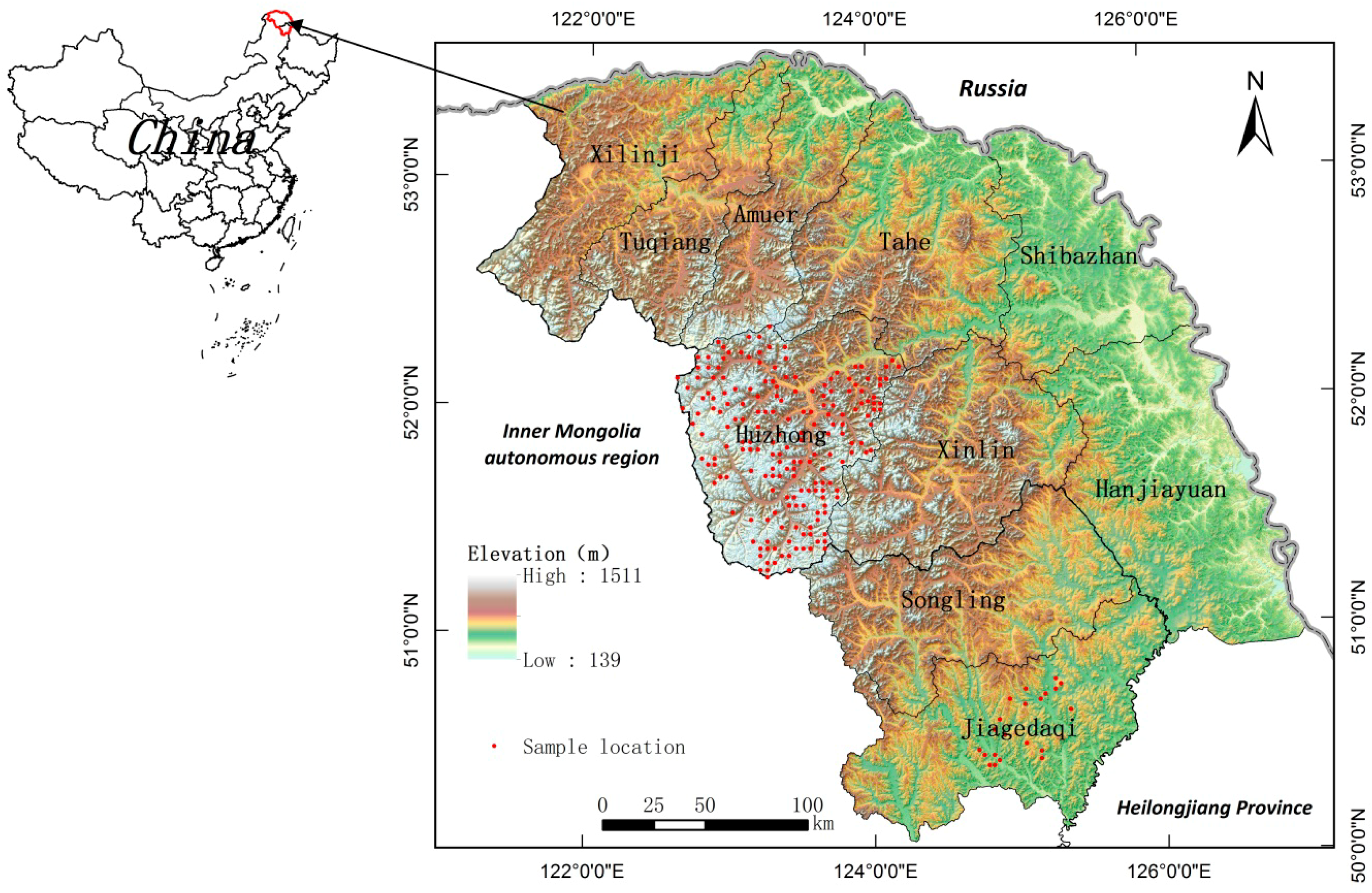
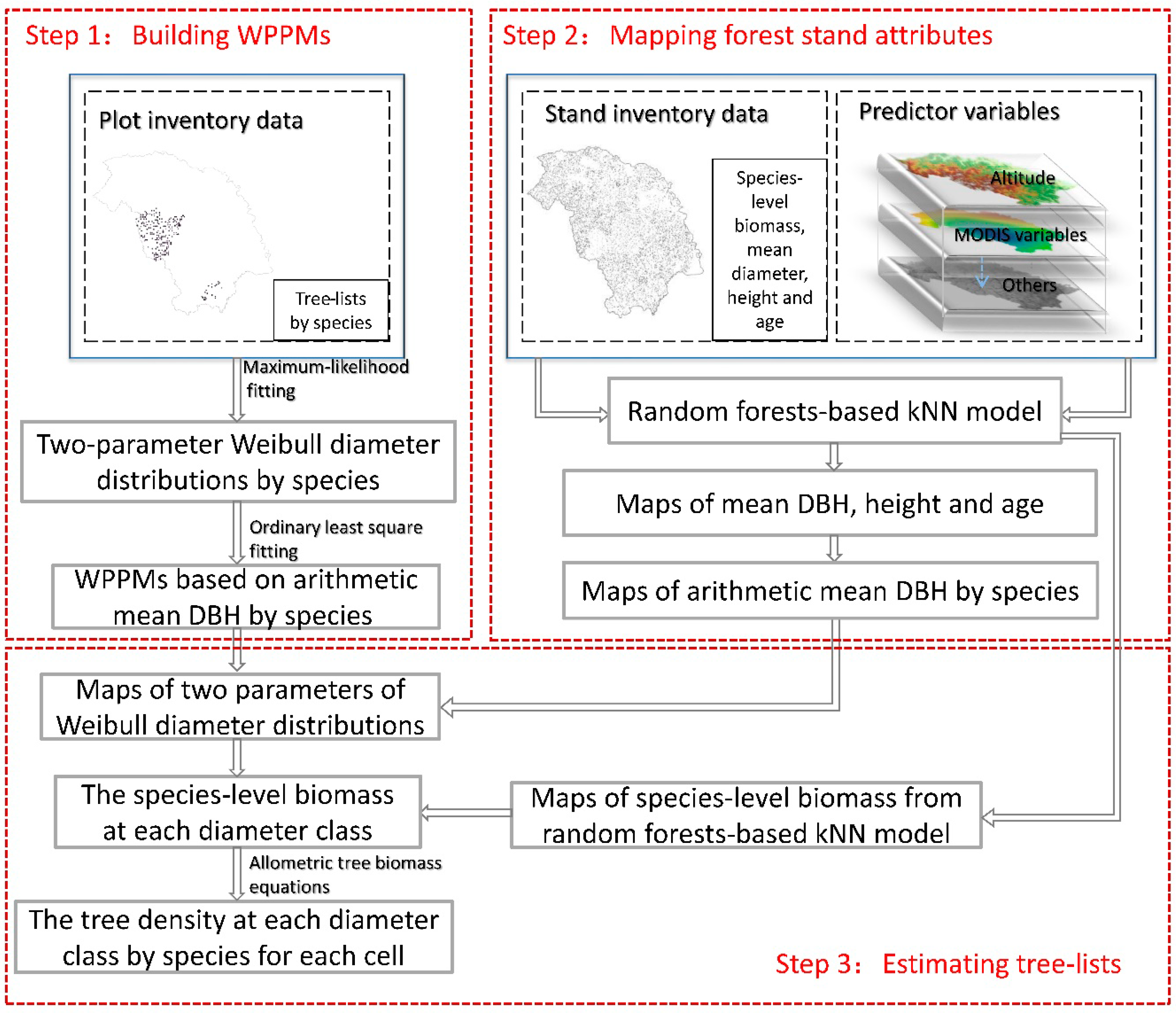
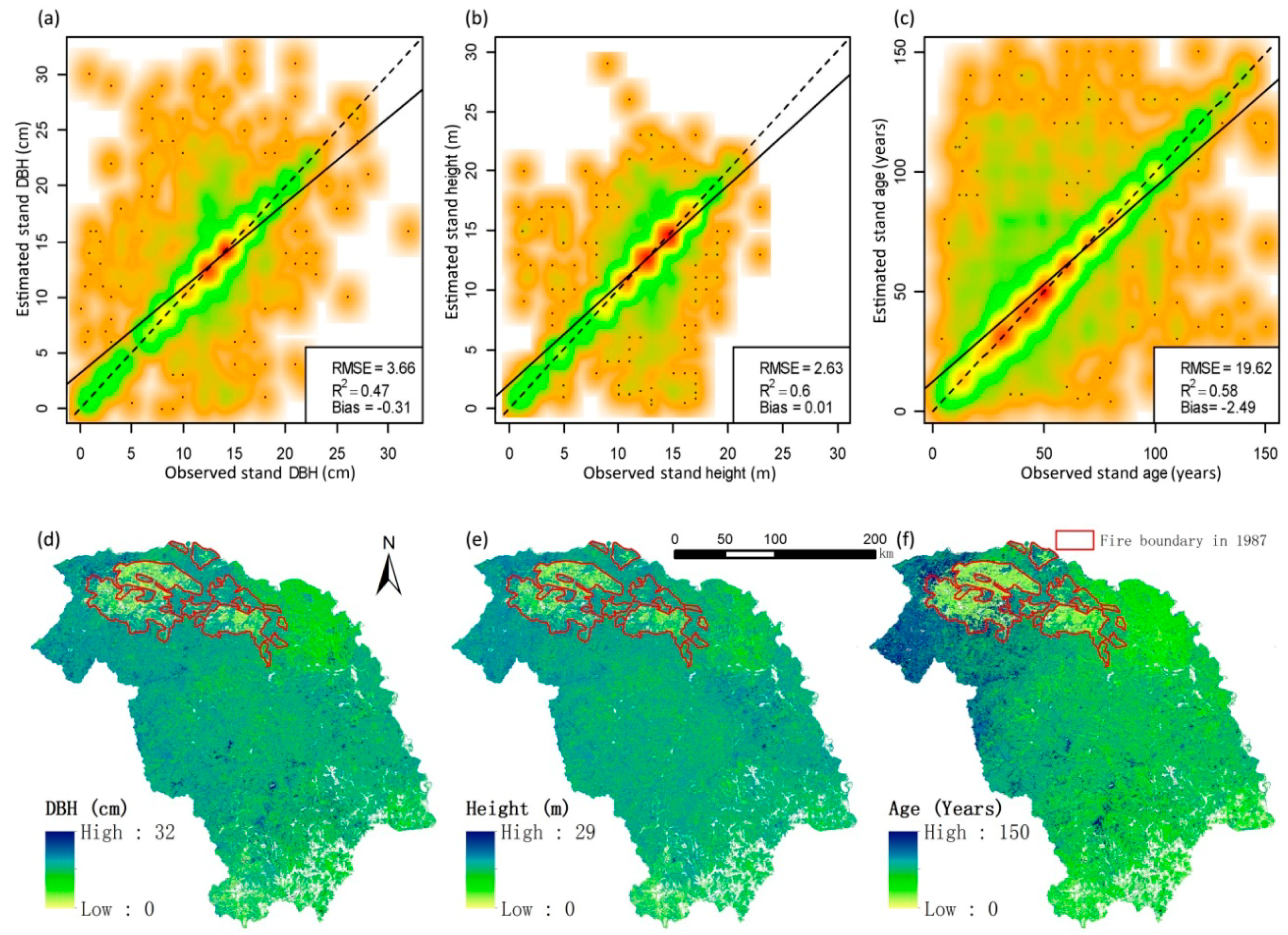
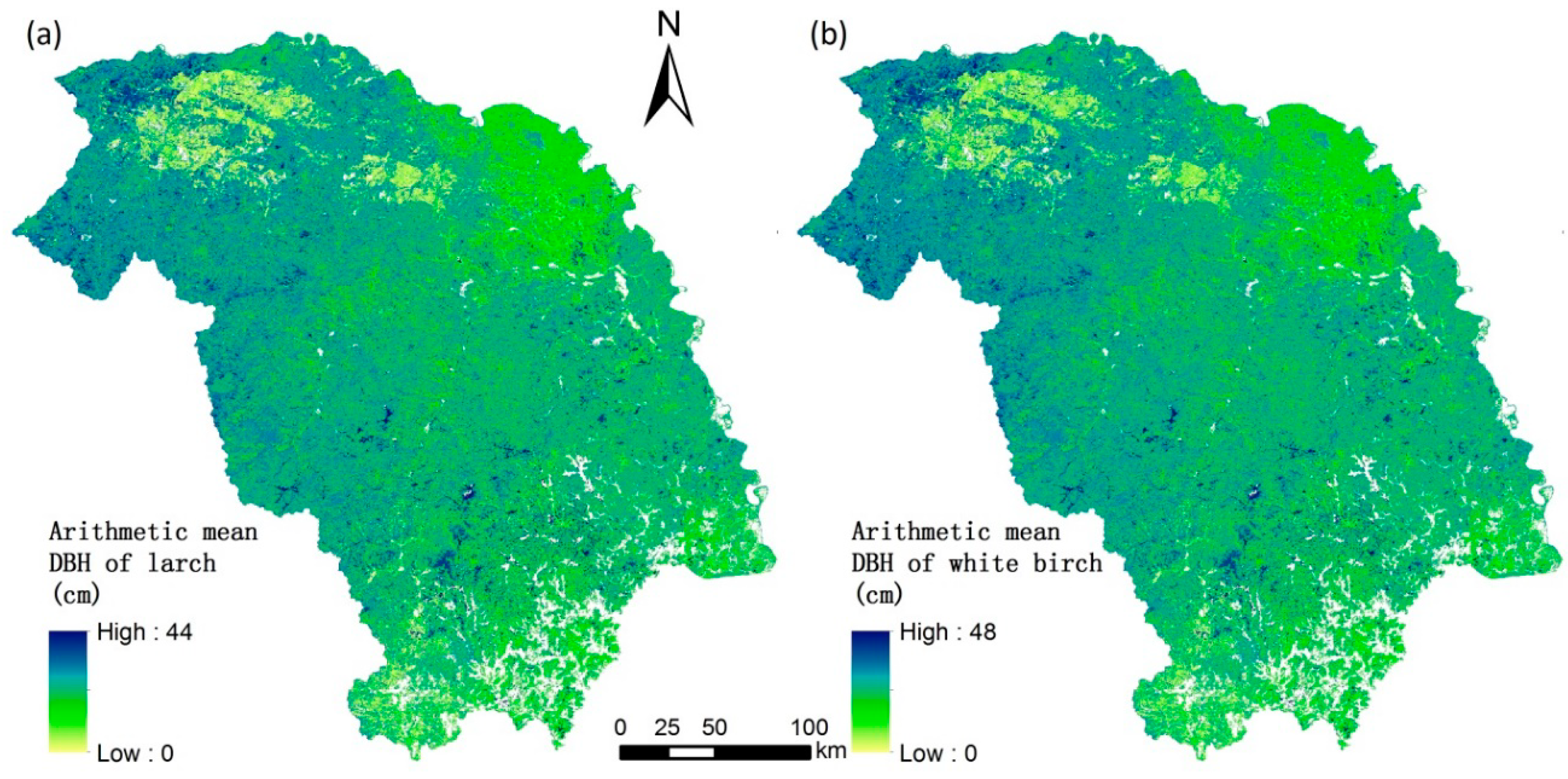

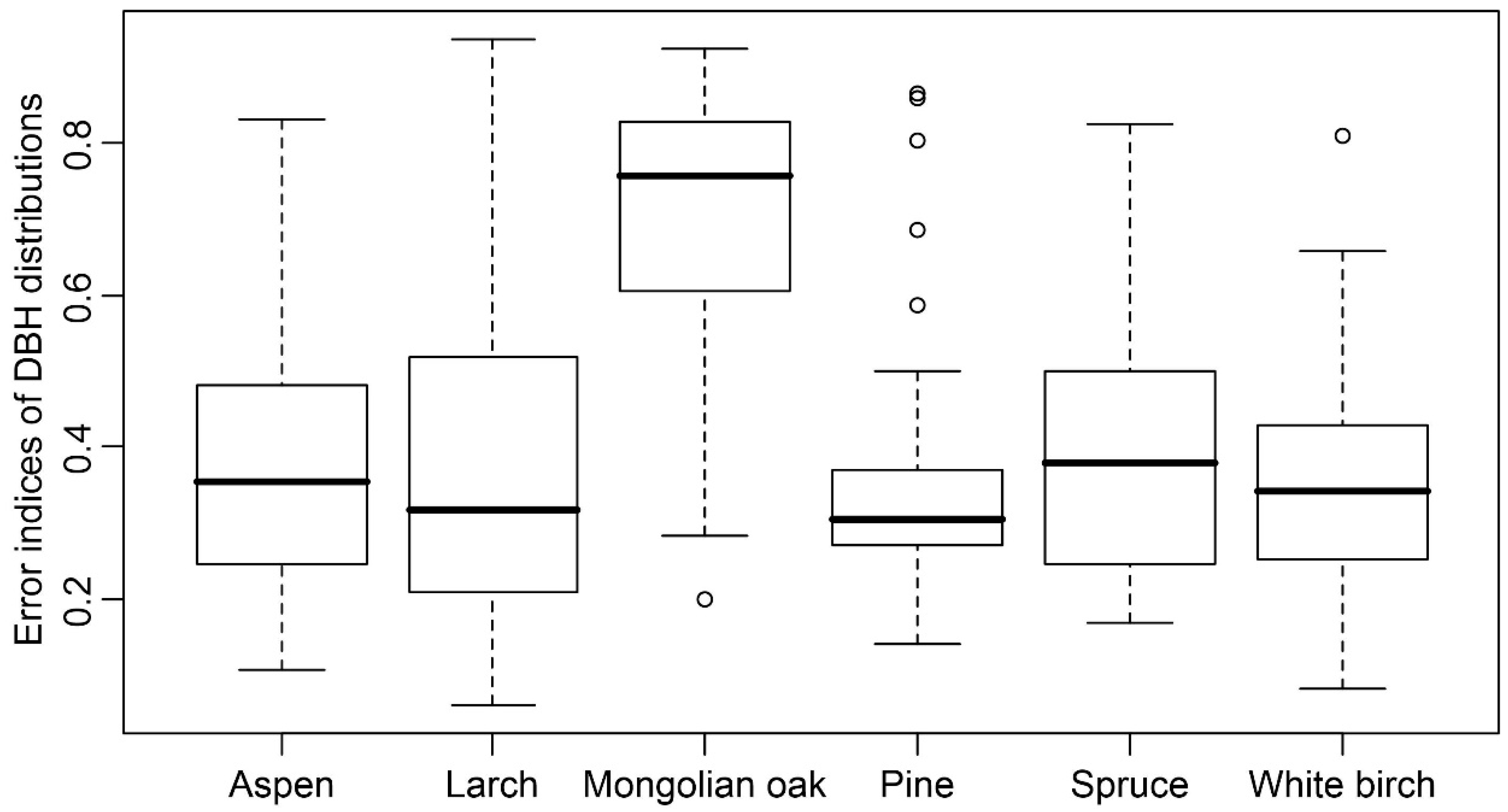
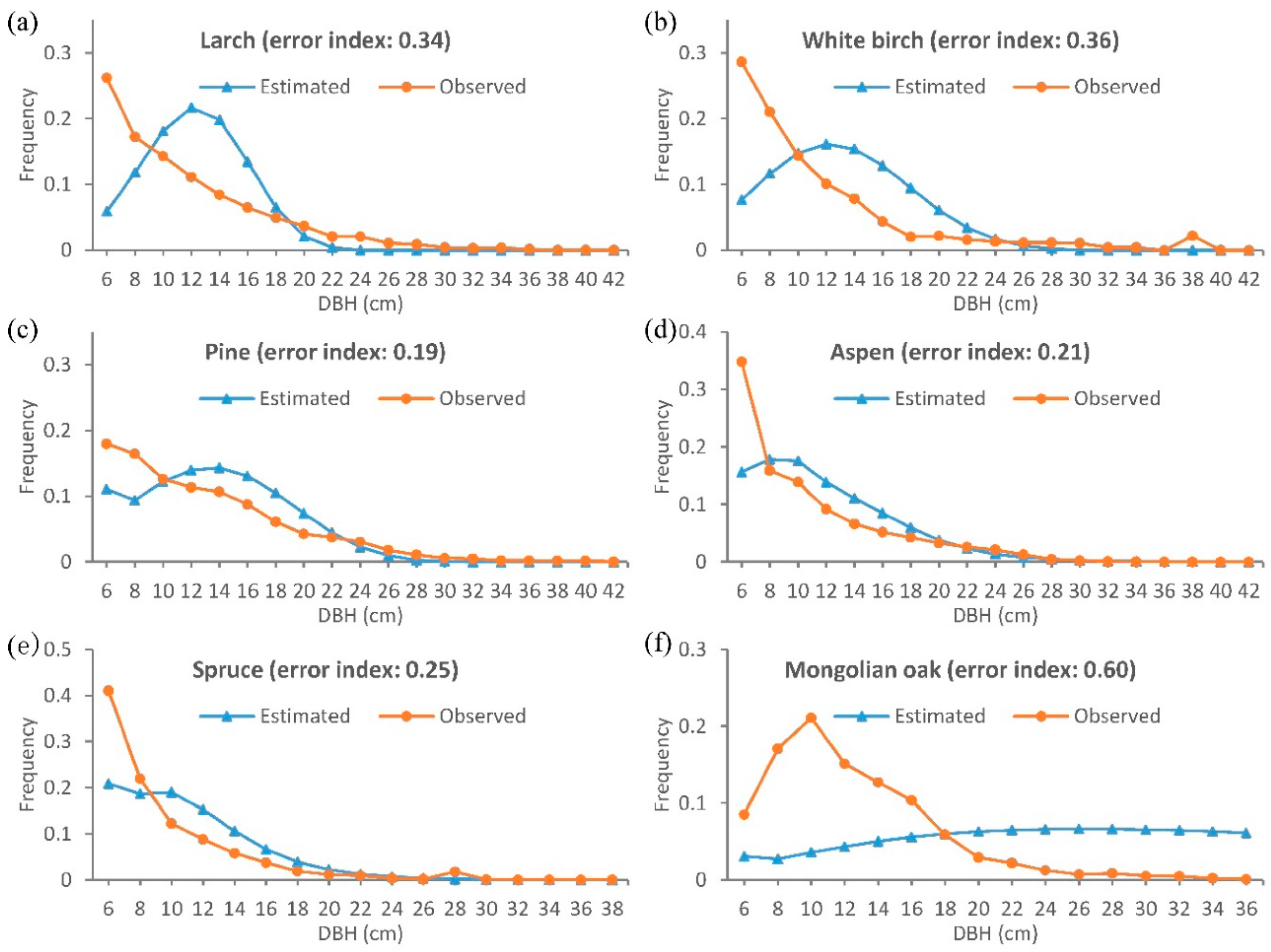
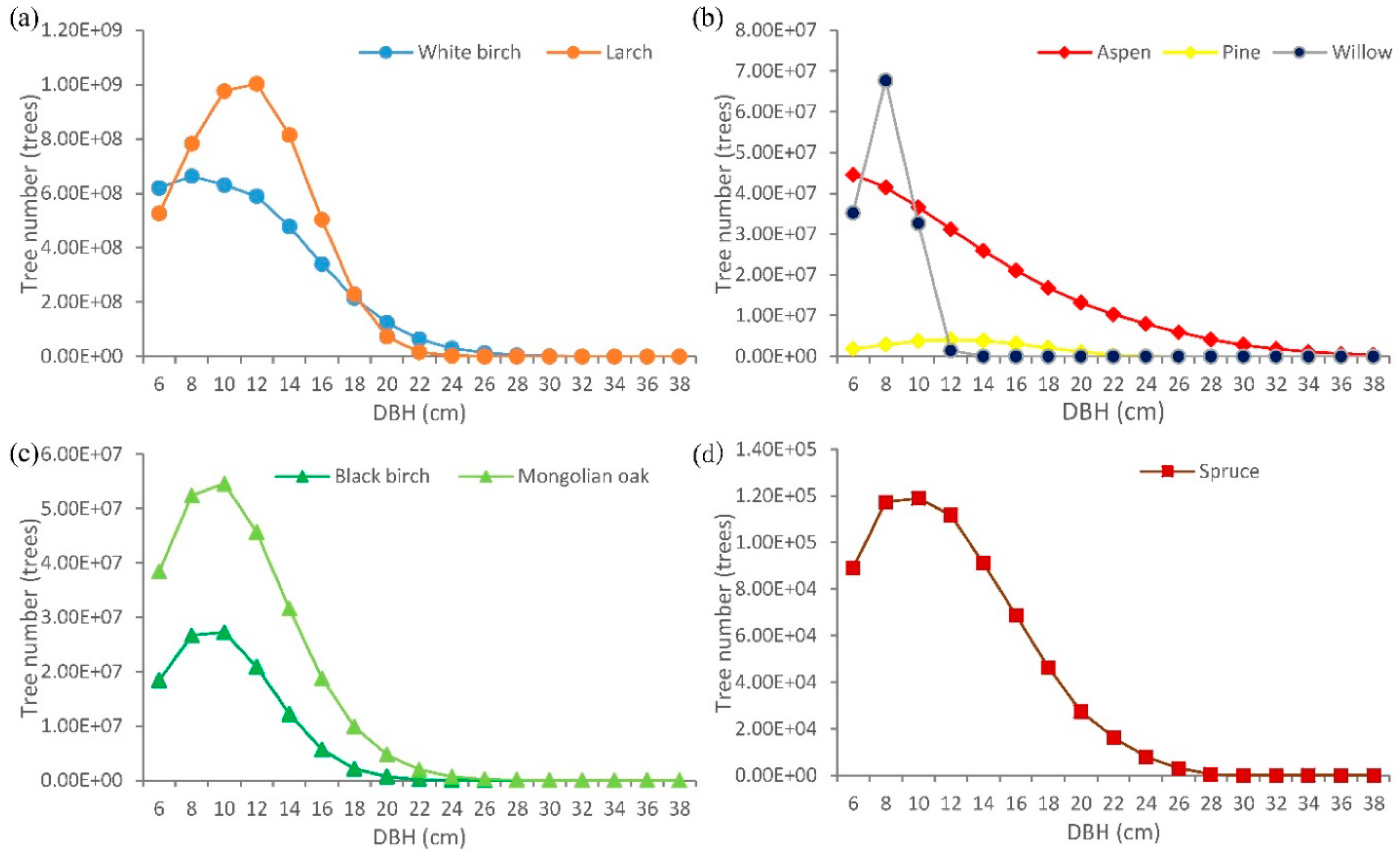
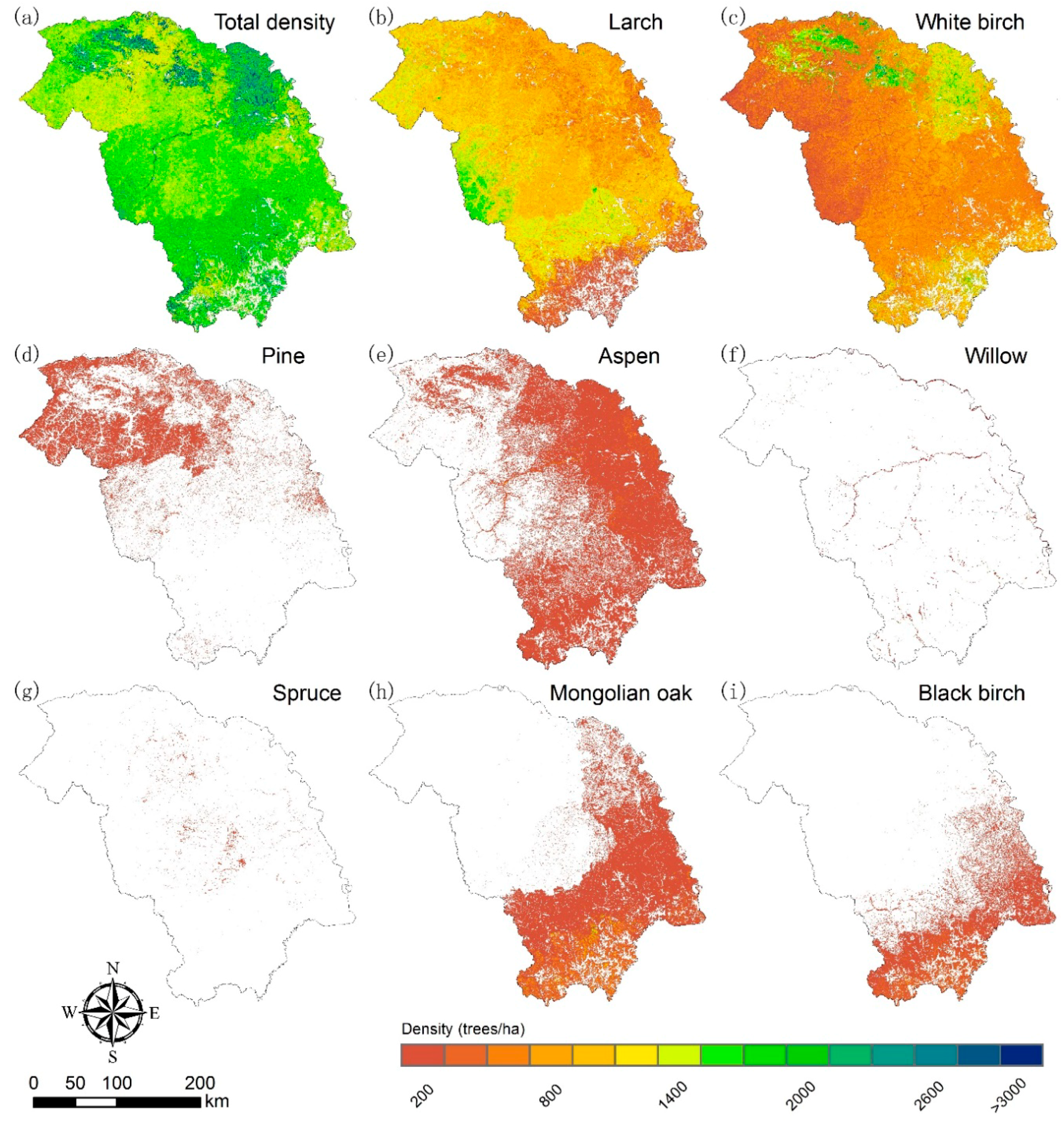
| Species | Equations | R2 | RMSE | Bias | p-value |
|---|---|---|---|---|---|
| Larch | d = 0.1972a + 1.5701 | 0.96 | 1.95 | 0.04 | 0.00 |
| White birch | d = 0.2287a + 2.222 | 0.96 | 0.95 | 0.00 | 0.00 |
| Pine | d = 0.2659a − 1.47 | 0.75 | 4.88 | 0.00 | 0.00 |
| Aspen | d = 0.3405a − 0.27 | 0.92 | 2.86 | 0.00 | 0.00 |
| Spruce | d = 0.1154a + 7.6919 | 0.33 | 3.16 | 0.00 | 0.00 |
| Mongolian oak | d = 0.1333a + 3.2679 | 0.87 | 1.89 | 0.00 | 0.00 |
| Species | Samples Passing the KS Test | Sample Number | Agreement (%) |
|---|---|---|---|
| Larch | 134 | 152 | 88.16 |
| White birch | 63 | 75 | 84.00 |
| Pine | 35 | 41 | 85.36 |
| Aspen | 26 | 40 | 65.00 |
| Spruce | 27 | 35 | 77.14 |
| Mongolian oak | 12 | 21 | 57.14 |
| Willow | 1 | 1 | 100.00 |
| Species | Equations | R2 | RMSE | Bias | p-value |
|---|---|---|---|---|---|
| Larch | b = 0.16782d + 1.62285 | 0.17 | 1.87 | 0.00 | 0.00 |
| c = 1.067865d − 0.508824 | 1.00 | 0.34 | 0.00 | 0.00 | |
| White birch | b = −0.18218d + 5.07848 | 0.22 | 0.74 | 0.00 | 0.00 |
| c = 1.153572d − 0.347148 | 1.00 | 0.12 | 0.00 | 0.00 | |
| Pine | b = 0.22833d + 0.08927 | 0.20 | 1.11 | 0.00 | 0.01 |
| c = 1.08108d + 0.51344 | 0.99 | 0.21 | 0.00 | 0.00 | |
| Aspen | b = −1.16886d + 4.95978 | 0.31 | 0.58 | 0.00 | 0.00 |
| c = 1.153572d − 0.359169 | 1.00 | 0.08 | 0.00 | 0.00 | |
| Spruce | b = −0.21014d + 4.70319 | 0.29 | 0.47 | 0.00 | 0.00 |
| c = 1.16454d − 0.357322 | 1.00 | 0.07 | 0.00 | 0 | |
| Mongolian oak | b = 0.068193d + 1.245481 | 0.13 | 1.14 | 0.00 | 0.06 |
| c = 1.140851d − 0.21207 | 1.00 | 0.56 | 0.00 | 0 |
| Species | Mean Value of Error Indices | Minimum Value of Error Indices | Maximum Value of Error Indices | Standard Deviation of Error Indices | Error Indices of Summing All the Plots |
|---|---|---|---|---|---|
| Larch | 0.33 | 0.10 | 0.89 | 0.15 | 0.11 |
| White birch | 0.27 | 0.09 | 0.80 | 0.13 | 0.08 |
| Pine | 0.39 | 0.17 | 0.87 | 0.18 | 0.06 |
| Aspen | 0.43 | 0.17 | 0.79 | 0.19 | 0.04 |
| Spruce | 0.40 | 0.17 | 0.74 | 0.16 | 0.14 |
| Mongolian oak | 0.62 | 0.51 | 0.80 | 0.09 | 0.06 |
© 2018 by the authors. Licensee MDPI, Basel, Switzerland. This article is an open access article distributed under the terms and conditions of the Creative Commons Attribution (CC BY) license (http://creativecommons.org/licenses/by/4.0/).
Share and Cite
Zhang, Q.; Liang, Y.; He, H.S. Tree-Lists Estimation for Chinese Boreal Forests by Integrating Weibull Diameter Distributions with MODIS-Based Forest Attributes from kNN Imputation. Forests 2018, 9, 758. https://doi.org/10.3390/f9120758
Zhang Q, Liang Y, He HS. Tree-Lists Estimation for Chinese Boreal Forests by Integrating Weibull Diameter Distributions with MODIS-Based Forest Attributes from kNN Imputation. Forests. 2018; 9(12):758. https://doi.org/10.3390/f9120758
Chicago/Turabian StyleZhang, Qinglong, Yu Liang, and Hong S. He. 2018. "Tree-Lists Estimation for Chinese Boreal Forests by Integrating Weibull Diameter Distributions with MODIS-Based Forest Attributes from kNN Imputation" Forests 9, no. 12: 758. https://doi.org/10.3390/f9120758
APA StyleZhang, Q., Liang, Y., & He, H. S. (2018). Tree-Lists Estimation for Chinese Boreal Forests by Integrating Weibull Diameter Distributions with MODIS-Based Forest Attributes from kNN Imputation. Forests, 9(12), 758. https://doi.org/10.3390/f9120758





